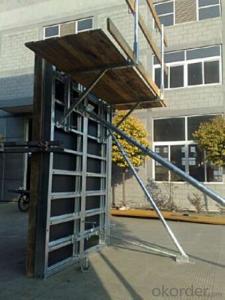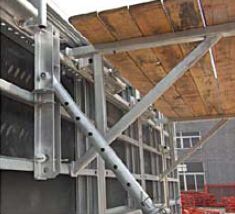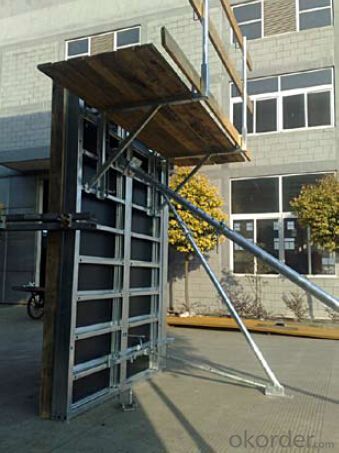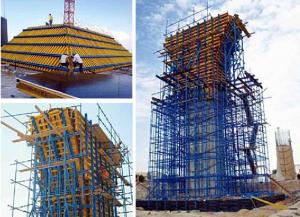Steel-frame Formwork Platform
- Loading Port:
- China Main Port
- Payment Terms:
- TT OR LC
- Min Order Qty:
- -
- Supply Capability:
- -
OKorder Service Pledge
OKorder Financial Service
You Might Also Like
Steel-frame Formwork SF-140
Characteristics:
◆ Few parts for fast forming.
◆ Max. Concrete pressure: 80KN/m2.
◆ Hot-dip galvanized steel frame.
◆ The thickness of plywood is 18mm & the panel is 14cm.
◆ Compatibility with Hunnebeck Manto system due to similar edge profile.
System Details & Application:
◆ Neat joint and fast assembling with aligning panel clamp.
◆ Flexible panel arrangement and height extension.
◆ The selection of panels.
◆ Kinds of panel connectors.
◆ Corner clamp application.
◆ Length adjustment application.
◆ Height adjustment & aligning strut.
◆ Walkway bracket & platform.
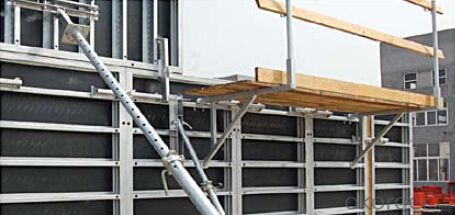
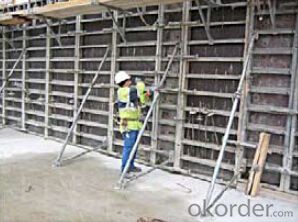
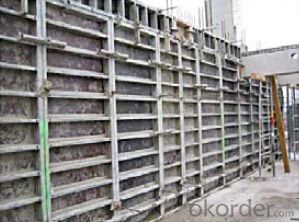
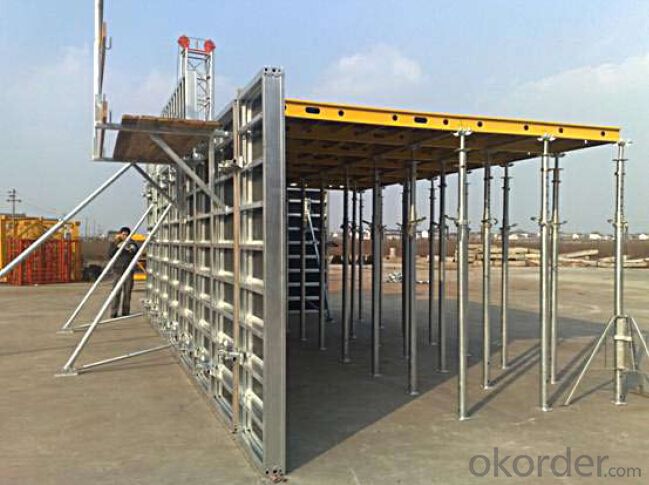
- Q: What are the different quality control measures for steel formwork construction?
- Some of the different quality control measures for steel formwork construction include regular inspections of the formwork for any defects or damage, ensuring that the formwork is properly aligned and leveled, checking for proper reinforcement and tie spacing, and conducting load tests to ensure the formwork can withstand the required loads. Additionally, quality control measures may involve monitoring the concrete pouring process, checking for proper curing of the concrete, and conducting regular checks on the formwork for stability and safety.
- Q: How does steel formwork handle concrete pouring and consolidation?
- Steel formwork is a popular choice for concrete pouring and consolidation due to its strength, durability, and ease of use. When it comes to handling concrete pouring and consolidation, steel formwork offers several advantages. Firstly, steel formwork provides a solid and rigid structure that can withstand the pressure exerted by the weight of the concrete. This ensures that the formwork remains stable throughout the pouring and consolidation process, preventing any deformations or collapses that could compromise the quality of the concrete structure. Additionally, steel formwork is highly resistant to moisture and chemicals present in the concrete mix, which helps to maintain its integrity and durability. This resistance ensures that the formwork does not get damaged or corroded during the pouring and consolidation process, thereby prolonging its lifespan and reducing maintenance costs. Moreover, steel formwork allows for efficient and precise concrete placement and consolidation. The smooth surfaces of steel formwork facilitate the easy flow and distribution of the concrete, ensuring that it fills all the required areas evenly. This helps to eliminate voids and air pockets, resulting in a denser and more structurally sound concrete structure. Furthermore, steel formwork can be easily adjusted and customized to meet specific project requirements. Its modular nature allows for easy assembly and disassembly, making it a cost-effective choice for various construction projects. The flexibility of steel formwork also allows for the creation of complex shapes and designs, enabling architects and engineers to realize their creative visions. In conclusion, steel formwork is an ideal choice for handling concrete pouring and consolidation due to its strength, durability, and versatility. It provides a stable and robust structure that can withstand the weight and pressure of the concrete, while also ensuring efficient and precise placement and consolidation. These qualities make steel formwork a reliable and practical solution for a wide range of construction projects.
- Q: How does steel formwork affect the speed of construction?
- Steel formwork can greatly enhance the speed of construction due to its numerous advantages. Firstly, steel formwork is highly durable and can withstand repeated use, allowing for multiple pours to be completed without the need for replacement or repair. This eliminates the downtime associated with traditional timber formwork, where the forms often need to be replaced after only a few uses. Additionally, steel formwork is known for its ease of assembly and disassembly. The modular nature of steel formwork allows for quick and efficient installation, reducing the overall construction time. This is particularly beneficial for large-scale projects where time is of the essence. Furthermore, steel formwork offers excellent dimensional accuracy and stability, ensuring precise and uniform construction. This eliminates the need for excessive rework and adjustments, saving both time and resources. Steel formwork is also known for its ability to handle high concrete pressures. This allows for faster pouring and setting of concrete, as there is no need to wait for the formwork to be fully cured before proceeding to the next pour. This results in faster construction cycles and increased productivity. Lastly, steel formwork is compatible with various construction techniques and can be easily adapted to suit different project requirements. It can be used for a wide range of applications, from simple slabs and columns to complex structures, enabling faster construction of diverse building elements. Overall, steel formwork significantly speeds up the construction process by offering durability, ease of use, dimensional accuracy, and compatibility with different construction techniques. Its ability to handle high concrete pressures and its modular nature contribute to faster construction cycles and increased productivity, making it an ideal choice for efficient construction projects.
- Q: Can steel formwork be used in areas with high wind uplift forces?
- Yes, steel formwork can be used in areas with high wind uplift forces. Steel is a strong and durable material that can withstand high wind forces, making it suitable for use in such areas. Additionally, the rigid and stable nature of steel formwork provides added strength and stability, ensuring the structure remains intact even under extreme wind conditions.
- Q: PVC building template introduction
- PVC building template is also called wood plastic formwork, plastic formwork, plastic formwork.PVC building template is an energy-saving and environment-friendly products, after the wooden template, composite steel formwork, bamboo plywood, all steel template and a new type of product. Can completely replace the steel formwork, formwork, timber, traditional energy saving and environmental protection, low cost amortization.
- Q: What is the difference between the steel template and the assembled steel template?
- Now the steel formwork has been slowly no longer in use, mostly use wooden template, because wood template is easy to shape, to adapt to the specific slab column easier, light weight and convenient construction, reasonable price and can be used repeatedly
- Q: What are the different types of reinforcements used in steel formwork?
- There are various types of reinforcements used in steel formwork, including steel bars or rebars, wire mesh, steel plates, and steel fibers. These reinforcements are strategically placed within the formwork structure to enhance its strength, durability, and load-bearing capacity.
- Q: What are the considerations when selecting the appropriate steel grade for formwork?
- When it comes to selecting the right steel grade for formwork, there are several factors that need to be considered. First and foremost, the load-bearing capacity of the steel grade is of utmost importance. It must be able to withstand the weight and pressure exerted by the concrete and any additional loads during construction, while maintaining its structural integrity without any deformation or failure. Another crucial consideration is the corrosion resistance of the steel grade. Since formwork is often exposed to moisture and chemicals from the concrete, it is vital to choose a steel grade that can resist corrosion. This will ensure the longevity and durability of the formwork, avoiding any safety hazards or costly repairs. Furthermore, the ease of handling and fabrication is an important factor. The selected steel grade should be easy to cut, shape, and weld, allowing for efficient and accurate construction of the formwork. It should also have good dimensional stability, ensuring that the formwork remains in the desired shape and size during use. Cost-effectiveness is also a significant factor to consider. While it may be tempting to choose a higher grade steel with superior properties, it is important to evaluate the project requirements and select a grade that offers the necessary performance at a reasonable cost. This will help optimize the budget without compromising the quality and functionality of the formwork. Lastly, compliance with industry standards and regulations should not be overlooked. The selected steel grade must meet the relevant codes and specifications set by governing bodies to ensure that the formwork meets safety standards and can withstand the intended loads and environmental conditions. By considering these factors, one can choose an appropriate steel grade for formwork that provides structural stability, durability, corrosion resistance, ease of handling, cost-effectiveness, and compliance with industry standards.
- Q: What are the considerations when designing steel formwork for elevated walkways?
- When designing steel formwork for elevated walkways, there are several important considerations to take into account. These considerations include structural integrity, safety, durability, and ease of installation. Firstly, the structural integrity of the formwork is crucial. The design must be able to support the weight of pedestrians and any additional live loads such as equipment or furnishings. The formwork should be designed to withstand any potential deflection or deformation, ensuring a stable and secure walkway. Safety is another paramount consideration. The formwork should have adequate handrails and guardrails to prevent falls and provide a safe environment for pedestrians. It is important to comply with relevant safety standards and regulations to minimize the risk of accidents or injuries. Durability is also a key consideration when designing steel formwork for elevated walkways. The materials used should be able to withstand exposure to environmental factors such as weather, temperature changes, and corrosion. Proper surface treatments and coatings can help enhance the durability of the formwork, extending its lifespan and reducing maintenance requirements. Additionally, ease of installation is an important factor to consider. The formwork should be designed in a way that allows for efficient and straightforward installation, minimizing construction time and costs. Modular designs or pre-fabricated components can help simplify the installation process and ensure consistency in the final structure. Furthermore, it is essential to consider accessibility and inclusivity when designing steel formwork for elevated walkways. The design should accommodate individuals with disabilities, providing appropriate ramps, handrails, and tactile indicators to ensure equal access for all users. Lastly, it is crucial to engage with experienced professionals such as structural engineers and architects during the design process. Their expertise and knowledge can help ensure that all necessary considerations are taken into account, resulting in a well-designed and functional steel formwork for elevated walkways.
- Q: How does steel formwork handle different concrete surface gloss levels?
- Steel formwork is an excellent choice for handling different concrete surface gloss levels due to its versatility and durability. The smooth and rigid nature of steel formwork allows it to create a consistent and even surface finish, regardless of the gloss level desired. When it comes to different concrete surface gloss levels, steel formwork offers several advantages. Firstly, it provides a smooth and uniform surface, which is crucial for achieving a high gloss finish. The steel panels are precisely constructed to create a seamless surface, minimizing any irregularities that could affect the gloss level. Additionally, steel formwork is highly resistant to warping or bending under the weight of the concrete, ensuring that the surface remains level and consistent. This is particularly important when aiming for a glossy finish, as any inconsistencies in the formwork could result in uneven concrete placement and subsequent variations in gloss. Furthermore, steel formwork is reusable, making it cost-effective and environmentally friendly. With proper maintenance and care, steel formwork can be used for multiple projects, allowing for consistent results in terms of gloss levels. In conclusion, steel formwork is an ideal choice for handling different concrete surface gloss levels. Its smooth and rigid construction ensures a uniform surface finish, while its durability guarantees consistent results. Steel formwork provides an efficient and effective solution for achieving various gloss levels in concrete construction projects.
Send your message to us
Steel-frame Formwork Platform
- Loading Port:
- China Main Port
- Payment Terms:
- TT OR LC
- Min Order Qty:
- -
- Supply Capability:
- -
OKorder Service Pledge
OKorder Financial Service
Similar products
Hot products
Hot Searches
Related keywords

